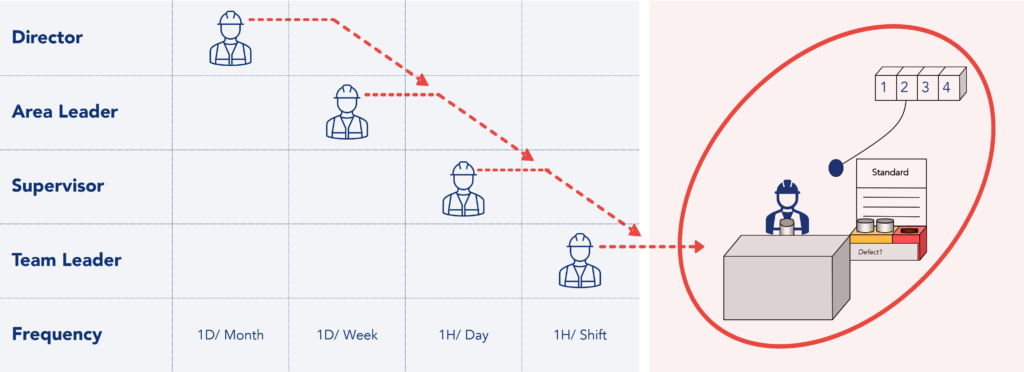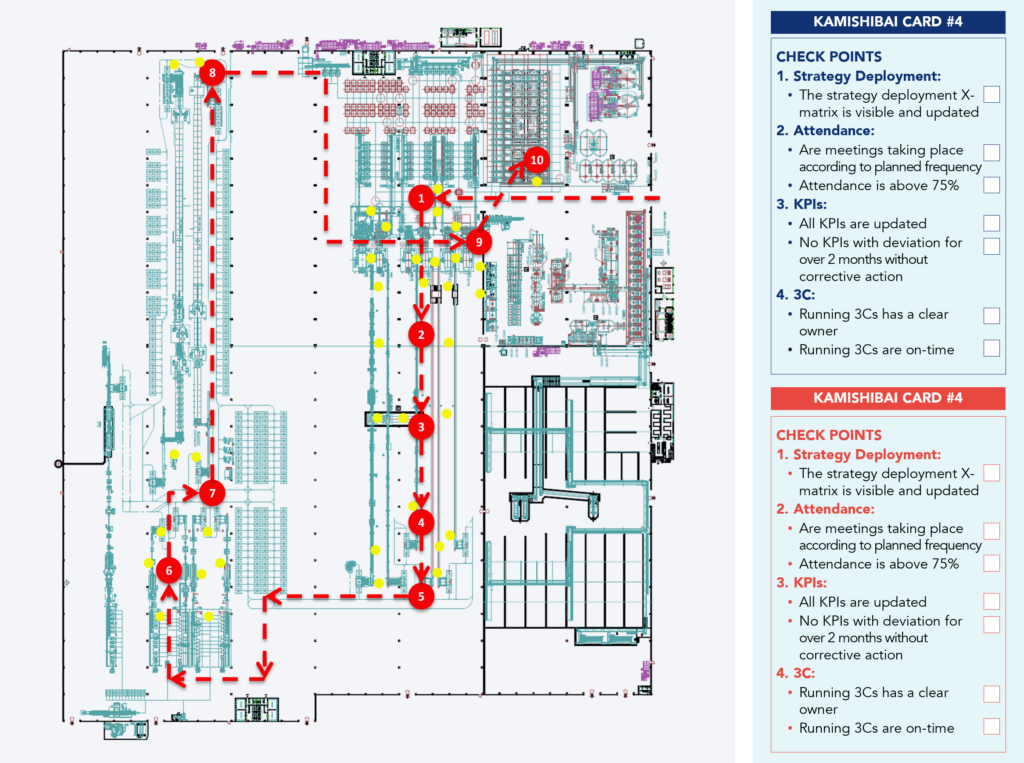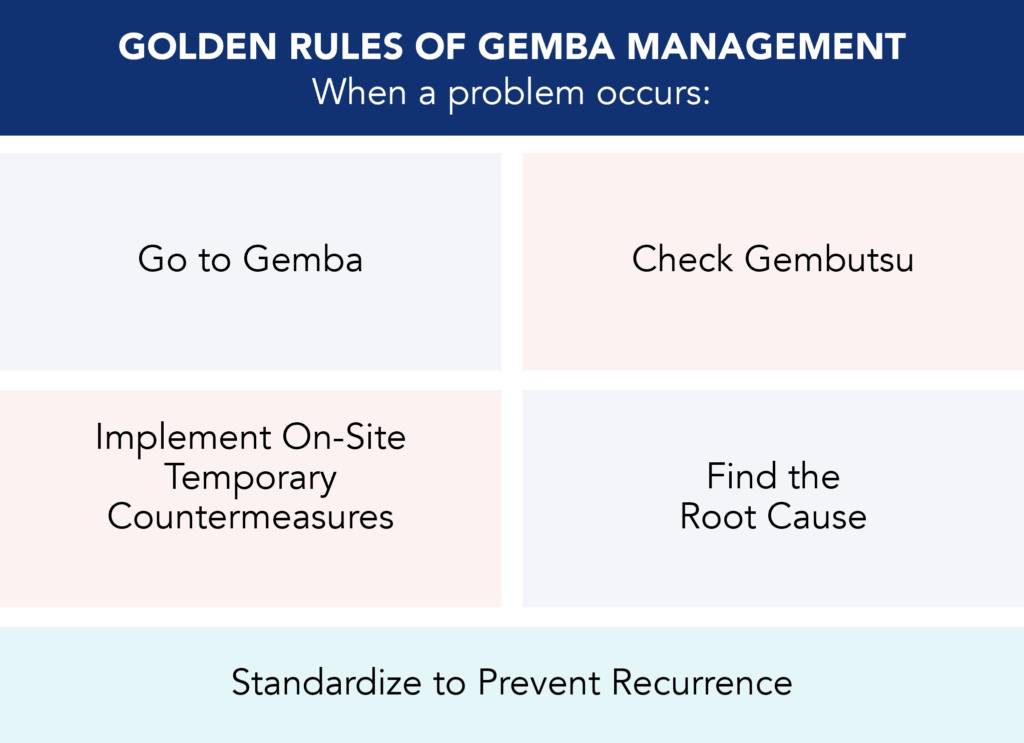In today’s corporate world, pursuing efficiency and continuous improvement is crucial for maintaining competitiveness and meeting rising customer expectations. Lean Management is a key ally in this journey toward excellence. Within this realm, a key concept is the Gemba, where work is performed.
This article explores the meaning of Gemba and discusses how the practice of going to Gemba, combined with Kaizen and Lean Six Sigma philosophies, can drive business performance. This approach allows for a more precise and detailed understanding of operational processes, identifying inefficiencies, and implementing effective solutions.
Gemba Meaning and Origins
The term “Gemba” originates from Japan and means “the real place” or “the place where things happen.” Within Lean Management, Gemba refers to the workplace where value is created, whether it is the shop floor, the service delivery space, or any area where operational work is carried out. To understand and improve processes, management teams, and leaders must go to the Gemba and watch the work and interactions performed.
Gemba is pivotal to the Toyota Production System (TPS), from which Lean Manufacturing stems. It was popularized by Taiichi Ohno, regarded as the father of TPS. Ohno advocated that a proper understanding of work processes can only be gained by going to the Gemba, observing and talking with workers, identifying waste, and seeking improvement opportunities.
In Lean Management, Gemba is not just a physical location but also one of its foundations. Going to the Gemba is essential for effective leadership, allowing leaders to see firsthand how work is being executed and what can be improved. This direct contact helps bridge the gap between management and operations, strengthening the commitment to continuous improvement.
What is a Gemba Walk?
Gemba Walks are an essential practice in the context of Kaizen and Lean methodologies. Leaders and managers go to the workplace, or Gemba, to observe and understand the operational reality. This hands-on approach lets processes, problems, and potential improvements be detected promptly.
They follow predefined routes to ensure the walks’ effectiveness and consistency, observing all areas and maintaining verification standards over time. During these walks, leaders focus on reinforcing key behaviors and habits for business success. This practice aligns leadership with daily operations and reinforces the targeted organizational culture.
Gemba Walks are often supported by tools such as Kamishibai cards or checklists. They help ensure no critical aspect is overlooked during Gemba visits. Additionally, they help verify whether employees understand the objectives and if standards are being met.
Conducted with a coaching mindset, Gemba Walks are not purely a supervisory tool but an opportunity to develop employees. Through these interactions, leaders can provide constructive feedback, encourage dialogue, and promote a learning and continuous improvement environment. All management levels are involved in confirming the work areas’ processes with different frequency levels.

Step-by-Step Approach for a Successful Gemba Walk
Organizations can maximize the impact of this practice by adopting a systematic and structured approach to conducting Gemba Walks. Here is the step-by-step approach for a successful Gemba Walk:
- Define the Scope: Establish which areas and processes to observe and which management levels will be involved in the Gemba Walk.
- Set Dedicated Time: Establish the frequency and duration of Gemba Walks for each management level.
- Select Verification Tools: Choose and develop (if not already available) specific Kamishibai cards or checklists to ensure that standards are met at each point along the route.
- Plan Gemba Walk Routes: Plan specific routes for each management level, including all critical points.
- Create a Gemba Walk Standard: Standardize the process, including routes with locations to visit, a list of processes to confirm at each end using Kamishibai cards or checklists, and the estimated duration for each location and the whole route. Define best practices with questions to ask.
- Train Leaders and Prepare Teams: Plan appropriate training for leaders at all management levels on the standards and objectives of the Gemba Walk, ensuring everyone is prepared to lead and participate effectively. Inform teams about the objectives of the Gemba Walks.
- Continuously Improve: Collect feedback and analyze data to identify areas for improvement. Adjust routes, verification tools, and training to improve the process continuously.

Key Components of Gemba Kaizen
Gemba Kaizen is a continuous improvement philosophy that focuses on the “real place” of work. Successfully implementing Gemba Kaizen requires adhering to several fundamental practices and principles that facilitate this workplace-focused approach to adding value, identifying problems, and implementing solutions.
Process standardization and 5S are at the core of Gemba Kaizen to eliminate waste and maximize customer value. These components are the backbone of any Kaizen initiative in Gemba and are vital for achieving Lean Management objectives.
Gemba and Management
In the context of Gemba Kaizen, management must become actively and consistently involved in Gemba. Managers are encouraged to leave their offices to interact directly with processes and employees in their work areas. This interaction promotes a deep understanding of daily activities and fosters effective communication at all organizational levels. It accelerates problem-solving, improves decision-making, and strengthens relationships with workers, increasing their engagement and recognizing individual efforts.
Management should listen to those at Gemba and provide the required conditions for improvements to be implemented by those working there. On the other hand, management is in charge of guiding Gemba employees by setting the organization’s strategic objectives and cascading them down to the teams on the shopfloor. Gemba and management hold equally essential roles – Gemba provides the product or service that meets customer’s needs, while management defines strategies and creates conditions for Gemba teams to improve continuously.
Standardization
Effectively managing daily activities and resources requires standards to ensure consistency over time. Whenever problems arise, leaders should investigate, identify the root cause, and review or implement new standards to prevent recurrence. Standards become a part of Gemba Kaizen and provide the foundation for daily improvement.
Standardization offers several advantages for teams:
- Ensuring process stability;
- Maintaining knowledge;
- Preventing repetitive errors;
- Providing a base for training team members;
- Offering a guide for task delegation;
- Providing a foundation for audits and diagnosis.
When all tasks in a process are standardized, the process becomes consistent and delivers the targeted results.
The Five S (5S) of Good Housekeeping
In Gemba Kaizen, the 5S method is a fundamental technique to improve efficiency through workplace organization. Implementing 5S helps create an organized, safe, and efficient work environment, fostering a culture of continuous improvement for operational success and employee satisfaction.
- Sort: Identify and remove unnecessary items from the workplace. This reduces clutter and frees up space, ensuring that only necessary materials and equipment remain accessible;
- Set in Order: After removing unnecessary items, the next step is to organize what remains. This involves orderly and logically arranging tools and materials, facilitating access, and minimizing waste;
- Shine: Clean the work environment. This also involves regularly checking the equipment’s operating conditions;
- Standardize: Create standards to maintain organization and cleanliness over time. This includes cleaning routines, standardized space layouts, tools or equipment, and other visual standards;
- Sustain: Reinforce the importance of following established practices and making 5S a daily habit. Discipline is crucial to ensure its benefits are maintained over time.
Eliminating Muda
Muda, which means “waste” in Japanese, is a main concern in Gemba Kaizen. Eliminating Muda is essential for improving efficiency, reducing costs, and increasing customer satisfaction. In the context of Lean Management, Muda refers to any activity that consumes resources but does not create value for the customer. Wastes are generally classified into seven types:
- Overproduction: Producing more than required or earlier than needed is the most severe type of waste because it generates several other kinds of Muda;
- People Waiting: Idle time when employees wait for materials or information;
- Material Waiting: Keeping more materials, parts, or products than necessary hides problems, ties up capital, and clutters up space;
- People in Motion: Movements of people that do not add value to the product or service;
- Transportation: Moving materials that do not add value to the final product or service;
- Overprocessing: Performing more operations or more complex operations than needed to deliver the product or service;
- Defects: Producing defective items or incorrect information requires rework or replacement, which generates additional costs and potentially affects customer satisfaction.
The Golden Rules of Gemba Management
At the heart of Gemba Kaizen are fundamental practices known as the golden rules of Gemba management. These rules guide leaders in addressing problems and implementing improvements in the workplace. When a problem occurs, leaders should:
- Go to Gemba: The first action a leader should take is to go to the Gemba. This means being in the place where work happens, allowing for the situation to be better understood. It also enables observing the problem in its natural context, facilitating accurate and immediate assessment;
- Check Gembutsu: Gembutsu means “the relevant objects” and involves checking the equipment, tools, parts, or materials involved in the problem. This helps gain a complete understanding of the nature of the problem, ensuring decisions are based on evidence and actual data;
- Implement Temporary On-Site Countermeasures: Take temporary measures to mitigate the problem. These immediate actions are not definitive solutions but are essential to get the situation under control and prevent the problem from worsening, providing time for deeper analysis and developing long-term solutions.
- Find the Root Cause: Investigate, identify, and solve the problem’s root cause. This involves a comprehensive analysis to understand why the problem occurred. Identifying the root causes is essential for developing effective and lasting solutions;
- Standardize to Prevent Recurrence: Standardize new practices or improvements to prevent the same problem from recurring. This may involve updating standards, training employees in new practices, and monitoring compliance with the latest standards.

These rules form the grounds for effective Gemba management and reinforce a continuous improvement culture and accountability at all organizational levels. By following these steps, leaders can ensure problems are addressed systematically, and improvements are sustainable in the long term.
The Impact of Gemba on Business Performance
The concept of Gemba is critical to Lean Management – it’s essentially where improvement opportunities are observed. Implementing the “Going to Gemba” mindset in daily business operations significantly impacts business performance. Organizations can gain valuable insights into their processes by focusing on Gemba, identifying opportunities, and implementing improvements. However, this process also presents challenges, from cultural resistance to the need for proper training.
Value of Gemba in Lean Management
Developing an organizational culture based on Gemba profoundly impacts business performance, promoting an approach based on direct observation, active management, and leadership participation in operational processes. By regularly bringing various management levels closer to Gemba, companies can achieve several significant advantages:
- Continuous Improvement: The Gemba provides a platform for continuously identifying improvement opportunities and immediately solving problems. This increases efficiency and quality while reducing costs and lead time;
- Motivation and Engagement: Leaders who go to Gemba demonstrate commitment to the team and their daily challenges. This can significantly improve team motivation, increasing productivity and job satisfaction;
- Data-Driven Decisions: Going to Gemba enables decisions based on accurate data, ensuring they are practical and informed;
- Quick Response: Observing and responding to problems in real-time helps reduce downtime and increases the company’s agility in responding to market changes or internal issues.
Challenges and Solutions in Gemba Implementation
Implementing this Gemba-focused approach offers many benefits but is not without challenges. Here are some common obstacles and solutions to overcome them:
- Cultural Resistance: In some organizations, there may be resistance to change, especially from management teams not accustomed to moving to operational areas. Kaizen training and workshops can significantly help this process by demonstrating the value of the Gemba to all organizational levels;
- Lack of Commitment: Another challenge is ensuring practices like Gemba Walks become embedded and not lose strength over time. Standardizing the Gemba Walk process and integrating it into managers’ routines and performance indicators can help maintain this commitment;
- Inappropriate Behaviors: Leaders must know how to act at the Gemba. When a problem occurs, leaders and managers should not seek to blame but rather identify the problem’s root cause. An inappropriate stance can lead to a culture of hiding future issues. Awareness and proper training are essential to constructively prepare leaders to handle these situations.
Implementing a Gemba-oriented culture effectively requires a structured approach and a commitment to continuous improvement. Overcoming these challenges strengthens the organization’s capacity to achieve operational excellence and meet customer needs.
Still have some questions about Gemba?
Is Gemba part of Kaizen?
Yes, Gemba is a crucial component of Kaizen. Kaizen means “continuous improvement” in Japanese and is a philosophy that emphasizes waste elimination and value creation. Gemba, the place where value is created, is the focal point for these improvement activities.
Is Gemba a Lean tool?
Gemba is not a tool but a fundamental concept within the Lean system. It is considered the “real place” where work is performed. In Lean Management, going to the Gemba is crucial for understanding operational processes and finding efficient ways to eliminate waste and improve processes. While Gemba is not a traditional tool like 5S or Kanban, it is an essential aspect of Lean strategies to facilitate continuous improvement and operational efficiency.
What is Kamishibai?
Kamishibai is a visual management and audit tool used within the Kaizen and Lean context. Originating from Japan, where it initially was a storytelling method using illustrated boards, it transformed into a verification tool in the Lean environment. Kamishibai cards list tasks or standards that need regular verification. Managers or leaders use these cards to ensure work standards are met and perform routine audits systematically and regularly. The card usually has two sides, green and red. When all points are met, the card will be displayed with the green side until the next audit date.
What are the 5 Gemba principles?
The principles of Gemba guide effective management at the place where value is created:
- Go to Gemba: The initial action in response to a problem is to go to the workplace for direct observation and assessment;
- Check the Gembutsu: Analyze the relevant equipment or materials to base decisions on tangible evidence;
- Implement Temporary Countermeasures: Apply immediate measures to control and mitigate problems, allowing time for deeper analysis;
- Find the Root Cause: Investigate thoroughly to discover the primary reason for the problem, aiming for long-term solutions;
- Standardize to Prevent Recurrence: Update standards and train employees on new practices to prevent future occurrences.
These principles promote a systematic approach to problem-solving and continuous improvement at Gemba.
See more on People & Culture
Find out more about improving your organization
